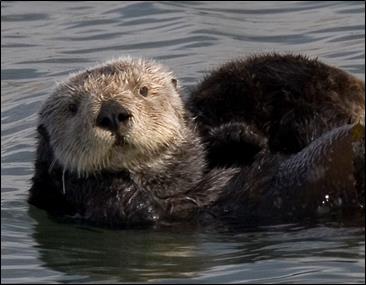How has the growing sea otter population affected the marine environment?
Project Dates
1994-2012
Did You Know?
Sea otters have voracious appetites, fueling a metabolic rate two or three times that of comparably sized terrestrial mammals. To survive in their cold-water environment, sea otters must consume 20-30% of their body weight in food daily.
Introduction

By 1900, sea otters had been exterminated from nearly the entire North Pacific Ocean. No populations existed from Prince William Sound, Alaska to Big Sur, California. In 1911 the International Fur Treaty provided the few hundred remaining sea otters with their first measure of protection. In the late 1960s, 403 sea otters were transplanted to several locations in Southeast Alaska, and the population began a remarkable recovery.
Sea otters began to colonize Glacier Bay proper in 1993. Ecologists and park managers hailed their return as a conservation success story but also anticipated profound changes in the structure of the nearshore marine community due to predation by this top-level carnivore. Beginning in 1994, this study documented changes in the marine community as sea otters became established. The study integrated three main avenues of research: 1) estimating sea otter abundance and distribution; 2) describing the diet of sea otters and predation rates; and 3) measuring the composition, abundance, and sizes of species comprising the nearshore marine bottom community prior to and subsequent to sea otter colonization.
The influence of sea otters in rocky-bottomed nearshore marine communities has been widely studied, and their role in controlling sea urchins and thus allowing the development of kelp forests is well known. In Glacier Bay, substrates suitable for the establishment of kelp forests are not common—much of the shallow water seafloor consists of mud, sand, gravel, or cobbles. This study focused on the impacts of sea otters on these soft-sediment-bottomed communities, which provide excellent habitats for the clams and other bivalves that are a food of choice for sea otters.
Findings

The sea otter population in Glacier Bay grew from five animals in 1993 to 8,508 in 2012. This is an average annual growth rate of 42%, which far exceeds the estimated maximum reproductive rate of increase of 24% per year for the species. Significant immigration in addition to reproduction within Glacier Bay must be occurring. Low growth rates of populations outside Glacier Bay support this conclusion. Lack of hunting pressure in the park may also contribute to the rapid population growth. (Hunting by Alaska natives is permitted outside the park, although pelts may not be sold except to other Alaska natives)
In observations of almost 6,000 foraging dives, the researchers confirmed an overall success rate of 92%. Sea otter diet consisted of 46% clam, 21% mussel, 4% crab, 15% urchin, and 14% other or unidentified prey.
Over the course of the study, researchers found significant changes in the size distribution and abundance of several preferred prey bivalve species. Diet and prey sampling data suggest that prey resources in areas of long-term occupation are being depleted, and a decrease in the growth rate of sea otters is predicted. However, there are still large areas of unoccupied habitat in Glacier Bay. The effects of recolonizing sea otters will continue to have profound and lasting implications for the structure and function of the nearshore marine community in and near Glacier Bay.
Last updated: September 13, 2016
